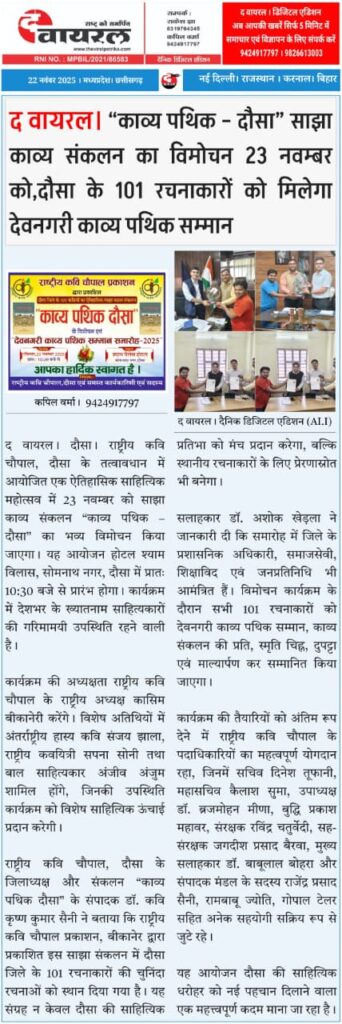The Viral | Dausa | 22 November 2025
Dausa mein Rashtriya Kavi Choupal ke tatvaavadhaan mein ek bhavya sahityik mahotsav ka aayojan 23 November ko kiya ja raha hai. Is avsar par sajha kavya sankalan “Kavya Pathik – Dausa” ka adhikarik vimochan hoga.

Yeh karyakram Hotel Shyam Vilas, Somnath Nagar, Dausa me subah 10:30 baje se shuru hoga, jahan desh bhar ke prasiddh sahityakaron ki upasthiti karyakram ko aur bhi garimamay banayegi।
Vishesh Atithi aur Adhyaksh Mandal
Karyakram ki adhyakshata Rashtriya Kavi Choupal ke Rashtriya Adhyaksh Kāsim Bikaneri karenge।
Vishesh atithiyon me shamil honge:
- Sanjay Jhala – Antarrashtriya Hasya Kavi
- Sadhna Soni – Rashtriya Kavyitri
- Anjeev Anjum – Prasiddh Bal Sahityakar
Unki upasthiti se karyakram ko vishesh sahityik unchai milegi।
101 Rachnakaron Ka Samman
District President aur sankalan ke editor Dr. Kavi Krishan Kumar Saini ne bataya ki is kavya sankalan me Dausa ke 101 rachnakaron ki chuninda rachnayein shamil ki gayi hain।
Yeh sankalan Dausa ki sahityik pratibha ko ek majboot manch pradan karega।
Saman Samaroh ke dauran sabhi 101 rachnakaron ko diya jayega:
- Devanagari Kavya Pathik Samman
- Kavya Sankalan ki Prati
- Smriti Chihn
- Duppatta
- Malyarparn
Vyavastha Mein Yogdaan
Karyakram ki taiyariyon me Rashtriya Kavi Choupal ke padadhikariyon ne mahatvapurn bhoomika nibhayi, jinme:
Dinesh Toofani, Kailash Suma, Dr. Brajmohan Meena, Buddhi Prakash Mahawar, Ravindra Chaturvedi, Jagdish Prasad Bairwa, Dr. Babulal Bohra, Rajendra Prasad Saini, Rambabu Jyoti, Gopal Tailor aur anya sahayak karyakarta shamil hain।
Ek Itihasik Sahityik Kadam
Yeh ayojan Dausa ki sahityik dharohar ko rashtriya star par ek nayi pahchan dene wala mahatvapurn kadam mana ja raha hai।
